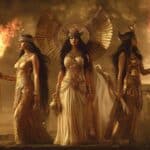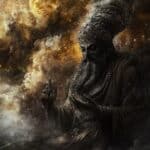
The Four Ages of Atlantis
Atlantis passed through 4 major ages, referred to as the Golden Age, Silver Age, Copper Age, and Iron Age before its ultimate destruction.

The Lost Civilization of Atlantis
The history of Atlantis is believed to date back millions of years, arising after the decline of Lemuria.

Ancient Timeline
Work in progress. A Helix shaped timeline including Lemuria and Atlantis.

Characteristics of Atlantis
Atlantis was an archipelago consisting of two large islands situated in the Atlantic Ocean near the Mediterranean Sea.
Ishtar, Inanna, Astarte, and Aphrodite share similar roles as goddesses of love, fertility, and war, despite differences.
Wadd in Islamic Tradition
In Islamic sources, Wadd is described as an idol worshipped by the people of Dumat al-Jandal, a key trading center in northern Arabia.

Idols worshipped by the people of Nuh
The names Wadd, Suwa’, Yaghuth, Ya’uq, and Nasr are mentioned in the Quran in the context of idolatry, specifically in Surah Nuh

Prophet Nuh (Noah) in the Quran
Nuh persists in delivering his message for a long time—950 years, according to the Quran. He approaches his people in various ways.

Atalanta
Atalanta is a heroine from Greek mythology known for her exceptional athletic abilities, independence, and her role as a formidable warrior.
In certain Phoenician texts, the deity Kronos was referred to as “El” or “Israel.” This association likely comes from an ancient reinterpretation of figures and their roles in myth.

Levites vs. Priests
This structure demonstrates that Levites, while connected by lineage, carried out a functional role that transcended mere tribal identity.

The Seven Noahide Laws
According to Jewish tradition, these laws were given by God as a framework for ethical conduct for all humanity, not just for Jews.
The Ten Commandments were given to the Israelites at Mount Sinai, a defining moment that came shortly after their exodus from Egypt.
The existence of other gods is acknowledged, but Judaism insists that these gods are not real or do not hold power like Yahweh.
Susanoo descended to earth and encountered an eight-headed serpent known as the Yamata no Orochi.

Mount Zaphon
Mount Zaphon held a prominent position in mythological and religious texts and was often associated with the chief deity Baal.

Mount Hermon
In Phoenician belief systems, the significance of high mountains like Hermon was related to their use as places of ascent.
A civilizing influence from a place called “Suernis” had affected parts of Asia, leading to the emergence of groups later recognized as the Semitic races.

Adam & Eve – 13,000 BCE
if Noah was born in 11,400 BCE, Adam would have been created around 13,056 BCE based on the ages provided in Genesis.

The legend of Cape Cham
Due to the wrath of the gods or test of resilience and faith. As the waters rose, many were forced to flee, leaving behind their homes and possessions.

Flood Stories from Around the World
God made holes in the sky for the waters to issue from by removing two stars from the Pleiades. He later closed the hole by borrowing two stars from the Bear.
The history of human civilization was presented as linear, with early humans portrayed as primitive and society advancing steadily over time.

The Sinking of Hiva
A series of catastrophic events that led to the submersion of Hiva. Massive earthquakes split the ground apart. The ocean itself rose in an unstoppable tide.
Hiva is often referenced in connection with the legendary ancestral homelands of various Polynesian peoples.
The Harmonic Convergence was a globally coordinated meditation and spiritual event that took place on August 16-17, 1987.

Earth’s history spanned approximately 6,000 years
The idea that Earth’s history spanned approximately 6,000 years was predominantly taught by religious authorities and widely accepted as the prevailing worldview for well over a millennium
Ultimately, Lund’s contributions faded into obscurity within mainstream science, though he remains a celebrated figure in Minas Gerais.

Yoruba mythology
In Yoruba mythology, the Great Flood is a significant event that marks a divine intervention by the Orishas, the gods of Yoruba culture.
The Yoruba religion, also known as West African Orisa (Òrìṣà) or Isese (Ìṣẹ̀ṣe), consists of the traditional religious and spiritual practices of the Yoruba people.
The “Crossing of the East Sea” is a famous story about the Eight Immortals traveling to a meeting, using their magical items to cross the East Sea.
Could the cultivation of Cucurbita stretch to a time before the Great Flood, approximately 12,800 years ago?

Guilá Naquitz Cave, Mexico
Guilá Naquitz Cave in Mexico dates back approximately 10,000 to 8,000 years ago (circa 8000–6000 BCE).














